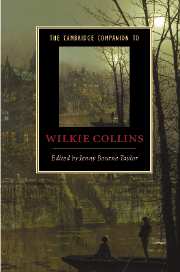Book contents
- Frontmatter
- Introduction
- 1 Collins’s career and the visual arts
- 2 The early writing
- 3 Collins’s shorter fiction
- 4 Collins and the sensation novel
- 5 The Moonstone, detective fiction and forensic science
- 6 The later novels
- 7 The professional writer and the literary marketplace
- 8 The marriage plot and its alternatives
- 9 Collins and Victorian masculinity
- 10 Collins and empire
- 11 Disability and difference
- 12 Collins and the theatre
- 13 The afterlife of Wilkie Collins
- Further reading
- Index
- Series List
10 - Collins and empire
Published online by Cambridge University Press: 28 January 2007
- Frontmatter
- Introduction
- 1 Collins’s career and the visual arts
- 2 The early writing
- 3 Collins’s shorter fiction
- 4 Collins and the sensation novel
- 5 The Moonstone, detective fiction and forensic science
- 6 The later novels
- 7 The professional writer and the literary marketplace
- 8 The marriage plot and its alternatives
- 9 Collins and Victorian masculinity
- 10 Collins and empire
- 11 Disability and difference
- 12 Collins and the theatre
- 13 The afterlife of Wilkie Collins
- Further reading
- Index
- Series List
Summary
Reviewing The Moonstone for the Athenaeum in July 1868, Geraldine Jewsbury noted that Wilkie Collins brought his readers to tears as the novel ended - not by uniting the English hero and heroine but by dividing three South Asian men. These men are Hindu priests who have together travelled to England and back, violating caste restrictions to restore a sacred Hindu diamond to its shrine in remote Kattiawar:
Few will read of the final destiny of The Moonstone without feeling the tears rise in their eyes as they catch the last glimpse of the three men, who have sacrificed their cast[e] in the service of their God, when the vast crowd of worshippers opens for them, as they embrace each other and separate to begin their lonely and never-ending pilgrimage of expiation. The deepest emotion is certainly reserved to the last.
Although critics often identify sentimentality as politically evasive, the sympathy that Collins evokes for the Hindus here is politically charged. In a novel published on the tenth anniversary of the rebellion that Victorians termed the 'Indian Mutiny' - an uprising that generated racial hatred towards South Asians among the British - Collins humanises figures commonly represented as bestial by his contemporaries and identifies as their rightful property a valuable diamond looted by British forces in Seringapatam fifty years before the main action of his story is set. Depicting the 1799 Siege of Seringapatam in his Prologue, Collins prefaces The Moonstone with an instance of British violence against Indians and suggests that their later acts of violence against Britons are marks of retribution triggered by an original, imperial crime.
- Type
- Chapter
- Information
- The Cambridge Companion to Wilkie Collins , pp. 139 - 152Publisher: Cambridge University PressPrint publication year: 2006
- 7
- Cited by



